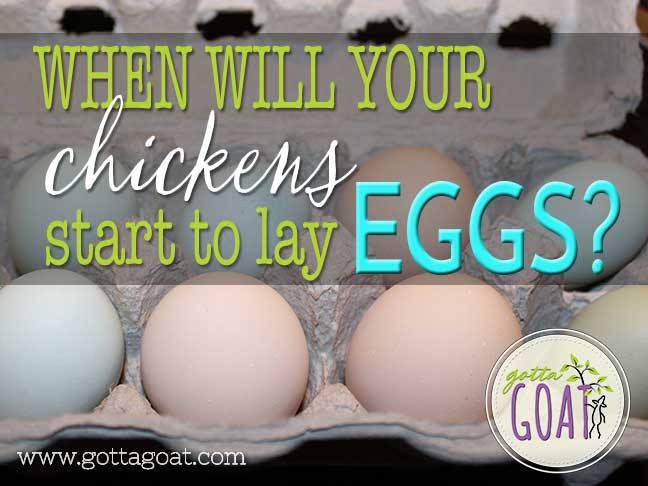
So you’ve got some new feathered friends, and you’re pretty sure that they are hens (and not roosters). You will certainly know for sure when they lay their first eggs… but when should you expect those new chickens to start laying?
If you’re anything like us, you are checking daily, hoping to find an egg in your nesting box!
Well, for us, we have finally started to see the first eggs from our new flock, after patiently waiting for several months. We had acquired a variety of chicks (most of them we got just after they hatched). Our oldest chickens in this flock are now six months, and our youngest are just over two months old.
As these chickens have been growing up, we’ve started tracking what to watch for, and specific dates that each started laying. Hopefully you’ll find some of this information helpful!
What Should You Watch For?
- Are they hens (pullets) or roosters (cockerels)? Kind of an obvious thing, but you’ll want to make sure the birds you are watching are actually hens! We are certainly not experts, but from all of our research, and just monitoring what is happening with our own chickens, we’ve noticed you should start seeing some distinct differences within the first 4-6 weeks:
- Roosters will start to develop darker (pink or red), and larger combs and wattles (different breeds will also develop different comb types, so do your research on the differences between hens and roosters for the breed(s) of chickens that you have),
- Roosters will have thicker legs (and you may notice spurs starting to develop on some breeds),
- Roosters may start to crow (we’ve had some start as soon as 6 weeks),
- Roosters will start to develop longer, pointed saddle and hackle feathers (these are the feathers at the base of their tails, and around the base of their necks), whereas hens should have more rounded feathers, and
- Rooster colours are more distinctive – many of the darker birds will tend to have a green shine to their feathers.
- Are the hens “hanging around” the nesting boxes?
- The first egg we found was a bit of a mystery. It was outside, at the base of a tree, and no evidence of which chicken had laid it. It was a very small, light coloured egg, so we thought it might have come from one of our Silkies. However, the next day we actually saw one of our Cream Brabanter x Marans (Maranters) making a little nest on the floor of the coop, and shortly afterward we found an egg there. Both of our Maranters had started to spend a lot more time in the coop, and since these are two almost identical girls, we weren’t sure which one had actually started to lay. A few days later though, we discovered two eggs, so we knew they were both laying. Within a week they started laying their eggs in the nesting boxes, and we now see both of them in there almost every day (although they both want to use the same one, often at the same time)!
- The next hen to lay for us was an Ameraucana. She started off by spending several hours in the coop one day, sitting in several of the nesting boxes. She would pick up feathers and drop them, and she kept climbing in and out of the nesting boxes. This behaviour continued for a couple of days, but we didn’t find any new eggs. Then one morning, just after we saw her in the nesting box, we found our first blue-green egg! The other two Ameraucanas followed suit, and surprisingly, both laid their first eggs in the nesting boxes (we are pretty sure they are teaching each other now).
- Originally, to help them out, we did put some “plastic” eggs in each of the nesting boxes. They often end up on the floor now, but this may have helped to show the first hens what is “supposed” to be done in there.
- Are the hens in the coop “getting noisy”?
- This was a bit of a surprise for us, as our older flock of chickens didn’t have this same behaviour. However, what we are seeing with our new girls is when they want to get into a nesting box (and there is another chicken already in the box they want), they start to make a “honking” sound. At first we thought something was wrong, as this was the same sound our older rooster makes when he is warning the hens about something, but after watching more closely, the hens will make this sound while they are waiting to get into a nesting box to lay their eggs. We have also noticed they make the same sound when they lay their egg too! So if your hens are getting noisier around the nesting boxes, this may be a good sign that eggs will soon follow.
At What Age Should Your Chicken Start to Lay?
With our chickens, we are still waiting to see when many of them will start to lay eggs. However, we now have 5 chickens laying eggs regularly (a pleasant surprise, as each is laying almost every day now).
- The Maranters laid their first egg at 18.4 weeks old. The second chicken started just a few days after the first. The eggs from the Maranters are a light pinkish-brown colour.

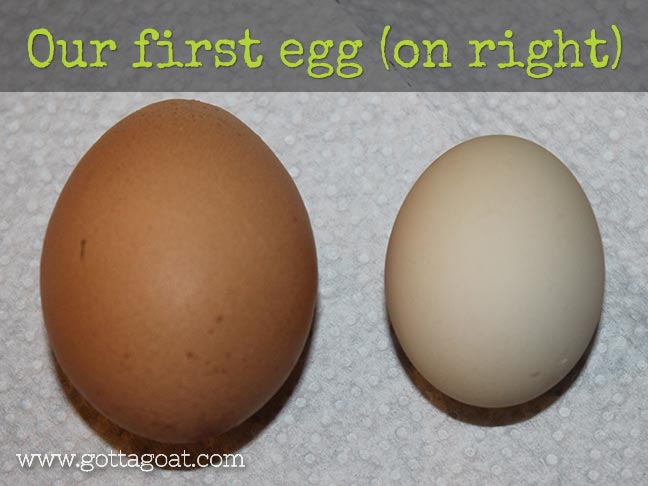
- The Ameraucanas laid their first egg at 17 weeks old. We have 3 Ameraucanas that are the same age. The second laid within 2 days of the first. The third Ameraucana laid two weeks after the first.

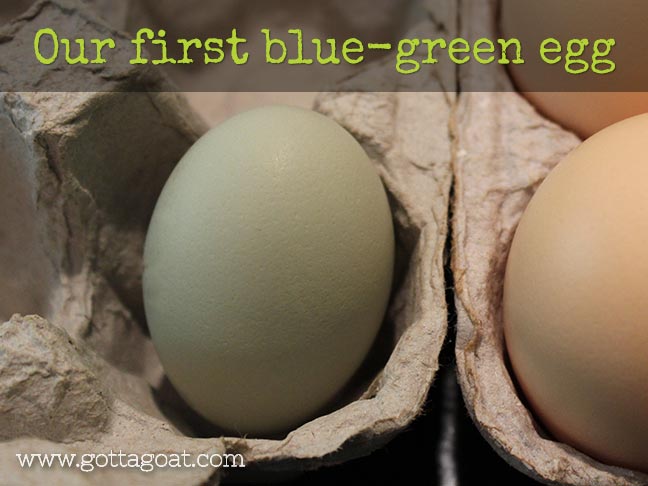

Our Silkies are currently 26 weeks old, and have NOT yet started to lay. Our next oldest hen is a Salmon Favarolles at 18 weeks, but she also has NOT laid yet. All the others are still under 16 weeks, so we’ll have to wait and see who is next! Typically, you would expect many of the breeds to start laying by 5 months, but it really varies (both by breed, and by individual hen). In any case, have patience – the eggs WILL COME!
The Eggs
For the first while, your new eggs will be “special”. Their colour, size and even shape will be a little different each day. Our Maranters have been laying for about 2 months now, and their eggs have become a lot more consistent. However, we are still getting some surprisingly large eggs on occasion (ouch!). The same has been happening with the Ameraucanas – their first eggs were quite tiny, but over the next couple of weeks we found them getting larger and more consistent in size and shape. Again though, there have been a few VERY LARGE blue eggs that show up in the nesting boxes.
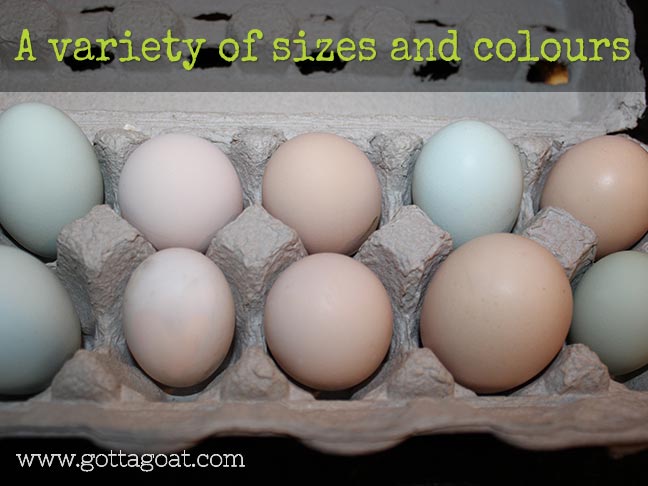
What is INSIDE the eggs is also “special”. We have had so many “double-yolk” eggs that we have lost count. We have started selling our eggs now, and some of our customers have commented that they too have found a few “double-yolkers”.
What was really surprising though was when we got our first “triple-yolk” egg! We have had two of these unique eggs now – both were those VERY LARGE sized eggs. We didn’t even know such things existed until we had our original flock of chickens (and got a few double-yolk eggs back then), but the triple-yolk ones are new to us. I’m pretty sure we have a few more of those – some of the eggs recently have been BIG! Who knows, maybe a quadruple-yolker?
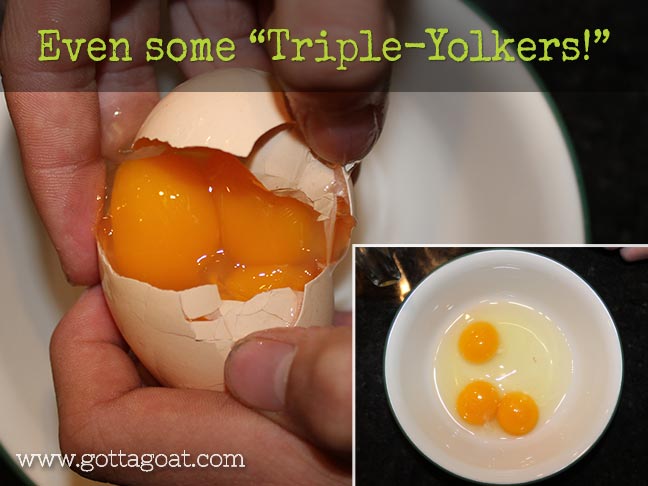
So that’s it for now – we’ll update our experiences with laying times once all the hens start to lay. Now we know that not everyone will appreciate how we can get so excited about chickens and their first eggs, but for those of you who do (probably anyone who has actually read this post), we hope you are having as much fun as we are waiting for those first eggs! Thanks for reading!

Hi I have just got 20new hens for my large coup.when should I expect eggs?
Hi Jimmy – It really depends on several things: how old your hens are; what breed they are; and even the time of year! If your hens were already laying when you got them, there could be a bit of a delay before they start laying again after moving them to your coop. If they are still young hens, then it will depend upon the breed. Most should start laying around 16-20 weeks old, but some could be earlier and some later. If it is winter, the shortened amount of daylight also affects their laying. And if they are going through a moult, or have gone broody, these factors too will affect their laying eggs.